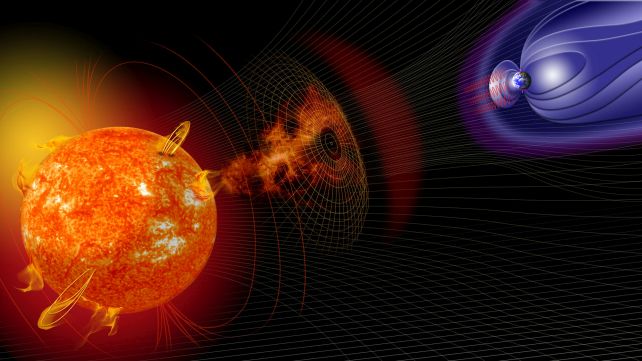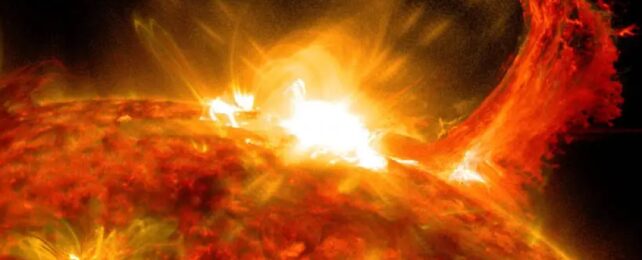The Carrington Event was a major reality check for a rapidly industrializing humanity. In September 1859, the Sun unleashed an eruption so powerful it sent electrical currents sweeping across Earth's surface, wiping out telegraph systems around the world, with fires and mayhem.
We've not seen its like since, but ancient evidence suggests that our Sun is capable of more – so very much more. In the rings of ancient, partially fossilized trees, scientists have found evidence of a solar storm at least an order of magnitude more powerful than the Carrington Event.
It took place, they say, some 14,300 years ago, well before there was a technology grid to disrupt. Such events, more powerful than Carrington, appear periodically in the fossil record. But this one is the most powerful ever seen.
Solar, or geomagnetic, storms are common here on Earth. They occur when the Sun erupts in a colossal flare or coronal mass ejection. If the eruption occurs in the direction of Earth, a huge influx of charged particles will hit our magnetosphere.

The effects of this are mostly pretty mild. The interaction between the particles and atmospheric molecules result in some pretty spectacular auroras. It can disrupt satellite and radio communications at certain bands.
During particularly powerful (and thankfully relatively rare) solar storms, the disruption to Earth's electromagnetic field can produce currents that can impact power grids.
Another quirk of solar storms is the effect they have on the radioactive carbon-14 constantly raining down on Earth. This radiocarbon is produced in the upper atmosphere as cosmic particles interact with atmospheric particles.
Carbon-14 is incorporated into organisms, such as trees and animals, and because it decays at a known rate, scientists can use it to determine when these organisms lived.
And it can also reveal historical solar eruptions, hidden in the annual rings of old trees.
"Radiocarbon is constantly being produced in the upper atmosphere through a chain of reactions initiated by cosmic rays," explains geologist Edouard Bard of the Collège de France and European Centre for Research and Teaching in Environmental Geosciences (CEREGE).
"Recently, scientists have found that extreme solar events including solar flares and coronal mass ejections can also create short-term bursts of energetic particles which are preserved as huge spikes in radiocarbon production occurring over the course of just a single year."
The solar storm that took place 14,300 years ago was found in subfossilized trees within the eroded banks of the Drouzet River in the Southern French Alps. A subfossil is one that has not yet completed the fossilization process.
The researchers created slices of these trees, and found a ring with a huge spike in radiocarbon, dated to around 14,300 years ago.

We have other records of this time, in ice cores extracted from Greenland. At around the 14,300 years ago mark, the researchers found in these ice cores a higher concentration of an isotope of beryllium that is also linked to a radiation storm.
The concentrations of both of these signatures are consistent with what we call Miyake events. These are incredibly powerful geomagnetic storms – way more powerful than the Carrington event.
Including this new discovery, nine Miyake events have been identified in the last 15,000 years, the most recent being around 774 CE.
We aren't entirely sure what causes them; solar storms are thought to be the most likely, but nearby supernovae could also be responsible. Either way, the effects would probably be the same here on Earth – devastating.
"Extreme solar storms could have huge impacts on Earth. Such super storms could permanently damage the transformers in our electricity grids, resulting in huge and widespread blackouts lasting months," says statistician Tim Heaton of the University of Leeds in the UK.
"A precise understanding of our past is essential if we want to accurately predict our future and mitigate potential risks. We still have much to learn. Each new discovery not only helps answer existing key questions but can also generate new ones."
The research has been published in the Philosophical Transactions of the Royal Society A.
